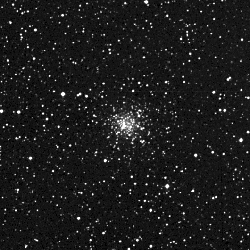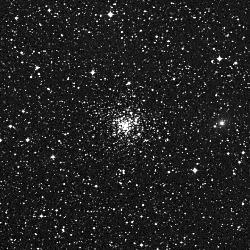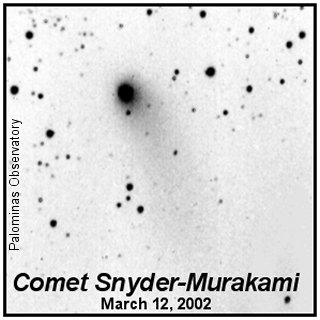This is a web-page version of my article published in
Tsukuba Hoshinokai Newsletter
gHoshizora Tsukubah (Starry Sky of Tsukuba), No.203 (April 14, 2002).
A miraculous comet- Comet Snyder-Murakami
Delicious Niigata sake!
@The night before the discovery, I said to myself, gA sip of sake before
going to bed will not hurt.h I put the large sake bottle over a Japanese-style
teacup intending to have just a small amount. gDarn! I poured too much of
it!h Thanks to my stupidity I emptied the cup only to wake up at one thirty
in the morning. Looking out, I found the sky clear. As a delinquent comet
hunter, I went back to bed, deciding to have a little more sleep and go out
for comet hunting, if I could. Bad luck! I woke up at 2.30 this time! I
had no choice but to force myself to go out for searching for comets. As
it was cloudy before I went to bed and continuing unsettled weather was forecast
for the following day, I never thought of searching for comets that evening.
I need to drive for 15 minutes to get to the observing site and another
30 minutes for putting on warm clothes, setting up the 46cm Dobsonian, and
getting the navigator ready. Altogether it will take about 50 minutes after
getting out of bed to start searching. I began my search at 3.20 on March
12, 2002, the day I made the discovery. I started sweeping vertically with
the eastern shoulder of Ophiuchus. Sweeping this particular area of sky
was not planned beforehand for that morning; it was decided after I arrived
at the observing site.

@My discovery owes to this sake gKirinzan Tokikazeh?@
My telescope
@I would like to discuss my telescope here. The idea of building the 46cm telescope all started
when I met Dr. Atsuyoshi Nishina at Kabasan (next to Mt. Tsukubansan) in
December 1999. Dr. Nishina owned a home-built 45cm telescope. He built the
telescope after reading gThe Dobsonian Telescope.h He encouraged me to build
a telescope, as he learned that I worked for Forestry and Forest Products
Research InstituteiI worked at the main office of the Institutejhaving easy
access to timber processing. I bought a copy of gThe Dobsonian Telescopeh
and ordered a mirror from Galaxy Optics in the U.S.
The primary mirror was 46cm (18 inches) with f 2037mm. I have an eyepiece,
which I bought from Kasai Trading, when it was for a limited sale. It is
a German-made 30mm Planokular. It has an apparent field of 88 degrees, and
used with the 46cm mirror, it provides a magnification of 68 with 1.3-degree
field of view. The finderscopes are a Telrad as well as Vixenfs modified
5cm telescope with a right-angle correct image prism and 7x power. The telescope
is also equipped with a Super Navigator (digital setting circle). It was
completed in July 2001 taking about one year with a help from staff in Wood
Engineering Department at my workplace.
Initially I was not quite keen on using this telescope for comet search.
I intended to use it to enjoy stargazing, as I thought there was no point
in doing visual search as LINEAR had been in operation. I made 20 observations
(excluding comet search) with the 46cm telescope from first light in July
2001 to my comet discovery in March 2002. I observed quasars, Pluto, M31,
a globular cluster in M31, M109, the central star of M57, the gringh of
the Saturn Nebula, Stephanfs Quintet, the Horsehead Nebula, etc.
After being transferred to Niigata in April 2001, I searched for comets
5 times in April, 3 times in May, once in June, using the 20cm telescope.
However, from the 46cmfs first light in July to January 2002, I searched
for comets only once. Some thought made me resume comet search using the
46cm telescope in February 2002.
A miracle on my birthday and search by the 46cm telescope
@In December the Japan Sea coasts suffer continuous inclement weather,
particularly with snow falls. In the winter of 2002 Tokamachi recorded a
snow depth of up to 2 meters, though it was just about the average. At the
time of my discovery there was still about 2-meter-deep snow around me. In
the midst of deep snow, I had been doing soul searching since the end of
the year.
I remember that I began watching the stars in my fifth year in primary
school . I gdiscoveredh a comet by accident
while observing with 5cm binoculars in the summer of@1975 in my second year
of junior high school. I asked Tokyo Observatory (the present National
Observatory) and found it was Comet Kobayashi-Berger-Milon. This prompted
me to grind a 10cm mirror and a 12.5cm one to start comet search, but my
intended search was interrupted by preparation for university entrance examinations
until after seeing Comet Hyakutake in 1996.
@gObserving by a large-aperture telescope is certainly exciting. But is
it really what I originally aspired to do? How can you drop again the comet
search you have somehow managed to continue? You have more favorable night
skies here than at Tsukuba...Your workload was steadily increasing, but things
have changed after the transfer. Visual search for supernovae may be an
idea. They sell eyepieces with a built-in image intensifier in America, which
make the limiting magnitude two magnitudes fainter... Itfs no good! It must
be comet search!h
@The problem is automatic surveys such as LINEAR. Although LINEAR is playing
havoc with visual comet hunting, it does not cover the western sky after
sunset and the eastern sky before sunrise according to LINEARfs home page. The 46cm telescope
must have captured P/2001 Q2 Petriew (10.5-11.0 magnitude), which was discovered
by chance at a star party.
It could also have detected C/2001 W2 BATTERS (CCD magnitude 13.8; visual
magnitude 12.0) under favorable conditions, which was found at Bisei in August
2001. I observed Comet Petriew by a 20cm telescope at 42x several days after
the discovery. I thought my chance of discovering it would be 50-50, even
if the comet passed the center of the field of view at an altitude 30-40
degrees because of light pollution.
@The skies over this declining town in Niigata are fairly bright affected
by light pollution. Sixth magnitude stars are visible at the zenith under
normal conditions and with averted vision 6.5-magnitude is possible. The
Milky Way is a fine sight in spite of a pale background, but M33 is hardly
visible to the naked eye. Light pollution is quite noticeable at low altitudes.
@The 46cm telescope is effective to beat light pollution and 12th-13th
magnitude comets can be discovered in the skies described above. Further
more, good star atlases such as Uranometria are available
and with a computer you can use star chart software and Real Sky. While
thinking about these things, I felt a strong urge:
@gIfm sure I can find a comet, if I use these resources. Very few people
have searched for comets systematically using a large-aperture Dobsonian.
Ifm sure I can succeed. I should start right now!h
@Come to think of it, it was on February 1, my birthday, when I resolved
firmly to start searching for comets again. And several days later, I learned
that Comet Ikeya-Zhang had been discovered in the evening sky on February
1.
Already the first discovery!
@In January and February there are only a few fine days and March is the
first month we can search for comets effectively. After the resolution on
my birthday, I searched with the 46cm telescope on February 7 and March 3,
and the third search on March 12 was my discovery day.
@On March 12 I started searching at 3.20. I captured two globular clusters,
NGC 6426, and NGC 6535. I checked them with the coordinates displayed on
Super Navigator and confirmed them with Uranometria. Next, I captured C/2000
WM1 LINEAR. Around 4.20 the object in question came roughly to the center
of the eyepiece field. I wondered if it was another globular cluster and checked
it with Uranometria. There was no object at the displayed coordinates on
Super Navigator. I thought Navigator showed wrong positions, an error caused
by low batteries. Navigator seemed to be correct, though, when I checked the
star patterns in Uranometria. I knew there were a number of known faint comets
in that particular region and I thought the possibility of this object being
a new comet would be less than 50%. gIf I check it with MegaStar (an American
star-chart software) when I get home, I will be able to confirm the presence
of a comet matching these coordinates.h


NGC 6462 NGC 6535
From Digital Sky Survey
Courtesy Association of Universities for Research in Astronomy,
Inc.
@After plotting the discovery position of the object on Uranometria, I
memorized the relative position of the comet against reference stars. I traced
the stars back to the object from M11 with 5cm binoculars several times to
make sure that there was no error in determining its overall position. I
calmed myself down and compared again the patterns of the stars around the
object with those in the star chart to confirm the existence of the object.
To make absolutely sure there was no error I tried different eyepieces to
eliminate the possibility of ghost images in the eyepiece. When I looked more
carefully, it seemed to have something like a tail in the southwest. I detected
a slight motion, but it was difficult to determine the exact direction of
movement, which I decided tentatively to be in the northeast.
Its magnitude was 13, I intuitively estimated. It was slightly brighter
than the fainter (NGC 6426) of the two globular clusters I captured a little
earlier and clearly fainter than the brighter one (NGC 6535). My final magnitude
estimate was 11, which was made after getting home, based on the magnitudes
of these globular clusters in the New General Catalog. The diameter of the
object was estimated to be 3f judging from my memory of the image of M57.
The comet had been visible until it was washed out by twilight at about 5
ofclock.
@At 5.30 I arrived home and turned on the computer. MegaStar displayed
the region where I found the object in question. It also showed all the known
comets visible in that area. This was the moment of truth! gNo comet at
this position!h. The object was definitely a new comet. I increased the scale
of the MegaStar chart and clicked at the position of the comet from memory
to determine its position as accurately as possible.


@@C/2002E2@Snyder-Murakami
@@@Photo by Snyder
A frustration in reporting the discovery
@Just in case, I downloaded the latest orbital elements, had MegaStar
display all the known comets, and checked it with NASAfs Comet Observation Home Page
and Mr. Seiichi Yoshidafs home
page. No matter what I checked, there was no known comet that matched
the object I had discovered.
@I had to report my discovery to Mr. Syu-Ichi Nakano and the National
Observatory. I wrote a fax message and sent it to Mr. Nakano and the National
Observatory in that order around 7.20. Then I telephoned them. As the recorded
message on Mr. Nakanofs answering machine said that he would start working
at 19.00, I didnft leave him any message. At the National Observatory, again
I heard the answering machine. I thought staff would report to work by 9
ofclock and left a message that the call was from Murakami, Niigata Prefecture,
who had sent the fax to the Observatory.
@I also tried to phone Mr. Osamu Miyazaki of Tsukuba Hoshinokai (Tsukuba
Star Club) around that time, because I remembered that he had told me to
call Mr. Akimasa Nakamura if there was any trouble with the confirmation of
a new comet. I made the call at about 8 ofclock, but the call wasnft answered.
I gave up because in Japan confirmation could be made only after about 18
more hours.
I tried the National Observatory a little after 9 again but was redirected
to the answering machine. I thought it was odd and called a different department
(Public Relations) of the Observatory at 9.30 to find out what was going
on. I was told that a staff member in charge of new astronomical objects had
not been reported to work yet. I asked if he would come some time in the
morning. The answer was gperhaps.h I felt it very unsatisfactory. The staff
member in question, I suppose, had some reason for not being there yet, but
with the use of the Internet so common around the world, any time delay would
allow an overseas discovery to be reported and officially announced....Mr.
Nakano is not available until 9. Thatfs it! I should directly call Smithsonianfs
Central Bureau for Astronomical Telegrams. @
@At 10.16 (according to my computerfs clock) I sent email to the Central
Bureau, but remembered I had forgotten to provide a description of the cometfs
motion. I sent second mail adding this information. Soon after, to my surprise,
I received a reply to my first email. The sender was Daniel Green, the person
Mr. Nakano called Dan in his articles in Tenmon Guide Magazine. His letter
was full of questions: my experience in astronomy, occupation, how the object
was determined to be a comet, if the object had moved, my mailing address,
so on and so forth. It took me a lot of time to answer all the questions
but I felt all these questions were to check if Murakamifs report was reliable.
Anyway, I was relieved that the Central Bureau had been now notified of my
discovery. I noted in my email to Dan that I sent the email because the National
Observatory staff member in charge was not at work and because Mr. Nakanofs
phone was redirected to the answering machine. It was not until a little
before 12 ofclock that I received a call from the National Observatory. Later
I learned from IAUC (International Astronomical Union Circular 7850) that
this comet had already been confirmed in Europe a little past 12 ofclock Japan
Time.
A Notice of Confirmation and an independent discoverer
@As Mr. Nakano was supposed to be working at 19.00, I called him after
19.00 but was forwarded to his answering machine. I left a message: gI am
Murakami from Niigata Prefecture who sent you a fax message this morning.
The weather forecast is not favorable. Please confirm my observation.h I
got a phone call from Mr. Nakano around 21.00. He said that the weather was
good there and that he had asked a number of people to confirm my discovery.
He also said that he had heard a lot about my discovery from Dan. When asked
by Mr. Nakano if the motion was fast, I could only say it was not particularly
fast. This might not have been adequate for observers who were to confirme
it from CCD images. I could have said it was about 1f per 30 minutes or something
like that, as it was not entirely unclear.

@Media interview . A lot of snow is still on the ground.
March 14, 2002
@
At half past one in the morning on March 13, I arrived at the observing
site and waited. It was cloudy and after a little while it started to snow.
Thinking it would be no use waiting any further, I stayed inside the car.
Then my mobile phone rang. gThis is Nakano from Sumoto. The comet was confirmed
in Europe and U.S.A. An observer in America discovered the comet before
you. Congratulations!h I thanked Mr. Nakano and headed home quite relieved.
@In the morning Mr. Nakano sent me IAUC 7850 which reported the discovery
of the comet and a copy of New Astronomical Objects Information from Oriental
Astronomical Societyfs Astronomical Calculation Section. He told me that
the comet would be registered as Comet 2002 E2 and that the name would be
Comet Snyder-Murakami.At the dawn of March 14 it cleared up. I went to the
observing site to have a look at a post-discovery appearance of the comet.
On March 13 and 14 I received about 100 phone calls from mass media and 10
reporters rushed to my place. The whole thing completely exhausted me compounded
by deprivation of sleep.
Mr. Snyder
@I received email from Mr. Snyder few days after the discovery. Mr. Snyder had already
been in his retirement. After retirement he moved from California to Arizona
where he could observe the stars in better conditions. He built an observatory
and was enjoying comet hunting and astrophotography. Before retirement he
had been doing computer-related work and had visited Japan a number of times.
@Mr. Snyder made this discovery after 70 hours of sweeping. In my case
it was after a little less than 30 hours during high school days plus 180
hours since 1996. For both Mr. Snyder and I it was fortunate that we made
the discovery in such short periods of time.
A miracle comet
@This comet is a gmiracleh comet to me. It came from the southern sky
on the Milky Way Railway*. It moved in a loop
near the Large Magellanic Cloud, then entered the Milky Way, and passed the
Southern Cross, Scorpius, and Sagittarius. It further traveled north and
was discovered in Aquila. It will continue its northward motion along the
Milky Way, passing Sagitta, Vulpecula, Lyre, Cygnus, then move out of the
Milky Way. Then it will draw a loop near the celestial north pole, while losing
its brightness. After that it will be on its journey to eternity, never to
be seen again.
@A dream becomes no longer a dream at the instant it is realized. It is
not the final destination or an end to the dream; it is rather a new starting
point. By realizing my dream I feel my life has become more fulfilling, my
thought toward life has deepened, and people around me were influenced in
a positive way. This little comet will continue its voyage through space
to eternity. Just like this comet, I wish to be able to keep my dream and
hope forever.
*This refers to a verse in "Ginga Tetsudo
no Yoru (the Night of the Milky Way Train)" written by the 19th-century poet
and novelist Kenji Miyazawa. See the detail at http://www2.gol.com/users/stever/kenji.htm





